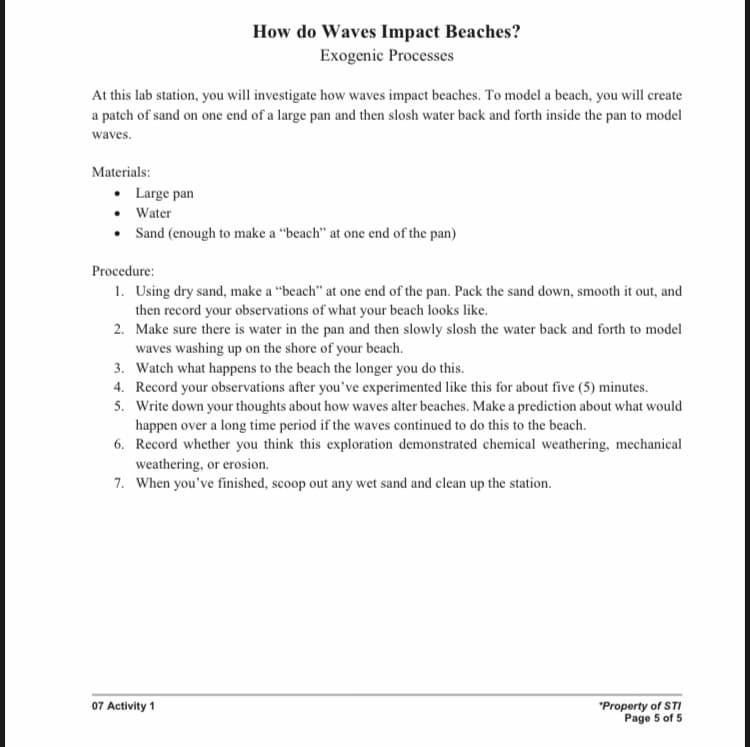How do Waves Impact Beaches? Exogenic Processes At this lab station, you will investigate how waves impact beaches. To model a beach, you will create a patch of sand on one end of a large pan and then slosh water back and forth inside the pan to model waves. Materials: • Large pan • Water • Sand (enough to make a "beach" at one end of the pan) Procedure: 1. Using dry sand, make a "beach" at one end of the pan. Pack the sand down, smooth it out, and then record your observations of what your beach looks like. 2. Make sure there is water in the pan and then slowly slosh the water back and forth to model waves washing up on the shore of your beach. 3. Watch what happens to the beach the longer you do this. 4. Record your observations after you've experimented like this for about five (5) minutes. 5. Write down your thoughts about how waves alter beaches. Make a prediction about what would happen over a long time period if the waves continued to do this to the beach. 6. Record whether you think this exploration demonstrated chemical weathering, mechanical weathering, or erosion. 7. When you've finished, scoop out any wet sand and clean up the station. 07 Activity 1 *Property of STI Page 5 of 5
How do Waves Impact Beaches? Exogenic Processes At this lab station, you will investigate how waves impact beaches. To model a beach, you will create a patch of sand on one end of a large pan and then slosh water back and forth inside the pan to model waves. Materials: • Large pan • Water • Sand (enough to make a "beach" at one end of the pan) Procedure: 1. Using dry sand, make a "beach" at one end of the pan. Pack the sand down, smooth it out, and then record your observations of what your beach looks like. 2. Make sure there is water in the pan and then slowly slosh the water back and forth to model waves washing up on the shore of your beach. 3. Watch what happens to the beach the longer you do this. 4. Record your observations after you've experimented like this for about five (5) minutes. 5. Write down your thoughts about how waves alter beaches. Make a prediction about what would happen over a long time period if the waves continued to do this to the beach. 6. Record whether you think this exploration demonstrated chemical weathering, mechanical weathering, or erosion. 7. When you've finished, scoop out any wet sand and clean up the station. 07 Activity 1 *Property of STI Page 5 of 5
Applications and Investigations in Earth Science (9th Edition)
9th Edition
ISBN:9780134746241
Author:Edward J. Tarbuck, Frederick K. Lutgens, Dennis G. Tasa
Publisher:Edward J. Tarbuck, Frederick K. Lutgens, Dennis G. Tasa
Chapter1: The Study Of Minerals
Section: Chapter Questions
Problem 1LR
Related questions
Question
What exogenic process is being mimic in this experiment, discuss briefly.

Transcribed Image Text:How do Waves Impact Beaches?
Exogenic Processes
At this lab station, you will investigate how waves impact beaches. To model a beach, you will create
a patch of sand on one end of a large pan and then slosh water back and forth inside the pan to model
waves.
Materials:
• Large pan
• Water
Sand (enough to make a "beach" at one end of the pan)
Procedure:
1. Using dry sand, make a "beach" at one end of the pan. Pack the sand down, smooth it out, and
then record your observations of what your beach looks like.
2. Make sure there is water in the pan and then slowly slosh the water back and forth to model
waves washing up on the shore of your beach.
3. Watch what happens to the beach the longer you do this.
4. Record your observations after you've experimented like this for about five (5) minutes.
5. Write down your thoughts about how waves alter beaches. Make a prediction about what would
happen over a long time period if the waves continued to do this to the beach.
6. Record whether you think this exploration demonstrated chemical weathering, mechanical
weathering, or erosion.
7. When you've finished, scoop out any wet sand and clean up the station.
07 Activity 1
*Property of STI
Page 5 of 5
Expert Solution
This question has been solved!
Explore an expertly crafted, step-by-step solution for a thorough understanding of key concepts.
This is a popular solution!
Trending now
This is a popular solution!
Step by step
Solved in 2 steps

Recommended textbooks for you

Applications and Investigations in Earth Science …
Earth Science
ISBN:
9780134746241
Author:
Edward J. Tarbuck, Frederick K. Lutgens, Dennis G. Tasa
Publisher:
PEARSON

Exercises for Weather & Climate (9th Edition)
Earth Science
ISBN:
9780134041360
Author:
Greg Carbone
Publisher:
PEARSON

Environmental Science
Earth Science
ISBN:
9781260153125
Author:
William P Cunningham Prof., Mary Ann Cunningham Professor
Publisher:
McGraw-Hill Education

Applications and Investigations in Earth Science …
Earth Science
ISBN:
9780134746241
Author:
Edward J. Tarbuck, Frederick K. Lutgens, Dennis G. Tasa
Publisher:
PEARSON

Exercises for Weather & Climate (9th Edition)
Earth Science
ISBN:
9780134041360
Author:
Greg Carbone
Publisher:
PEARSON

Environmental Science
Earth Science
ISBN:
9781260153125
Author:
William P Cunningham Prof., Mary Ann Cunningham Professor
Publisher:
McGraw-Hill Education

Earth Science (15th Edition)
Earth Science
ISBN:
9780134543536
Author:
Edward J. Tarbuck, Frederick K. Lutgens, Dennis G. Tasa
Publisher:
PEARSON

Environmental Science (MindTap Course List)
Earth Science
ISBN:
9781337569613
Author:
G. Tyler Miller, Scott Spoolman
Publisher:
Cengage Learning

Physical Geology
Earth Science
ISBN:
9781259916823
Author:
Plummer, Charles C., CARLSON, Diane H., Hammersley, Lisa
Publisher:
Mcgraw-hill Education,